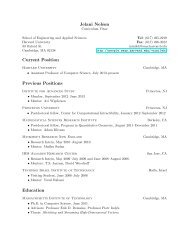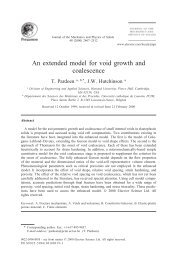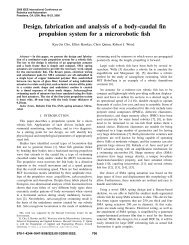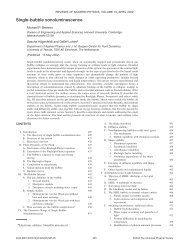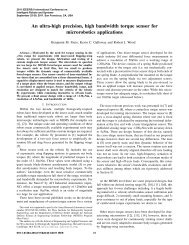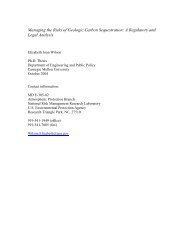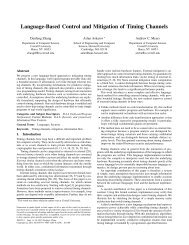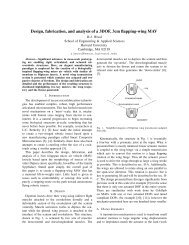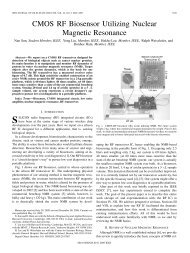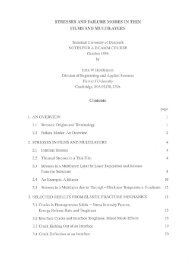Biological glass fibers: Correlation between optical and structural ...
Biological glass fibers: Correlation between optical and structural ...
Biological glass fibers: Correlation between optical and structural ...
You also want an ePaper? Increase the reach of your titles
YUMPU automatically turns print PDFs into web optimized ePapers that Google loves.
Fig. 4. Light-coupling experiments. (a) Free-space coupling of light to a free fractured spicule results in the entire fiber being illuminated. Right <strong>and</strong> Left areimages of the experimental setup in the presence <strong>and</strong> absence of room light. Referenced with arrows (a <strong>and</strong> b) are the input <strong>and</strong> output ends of the spicule.(Inset) Output of the spicule imaged on a screen. (b) Transmission <strong>optical</strong> image of a spicule embedded in epoxide. The 2-m core region is brighter than thecladding, showing that the fiber acts as a single-mode (few-mode) waveguide. (c) Transmission image of a freest<strong>and</strong>ing spicule. Entire fiber is lit up, showingthat the fiber acts as a highly multimode waveguide. (d) Light coupling into the spined regions of the fiber. (Upper) Optical micrograph of the original fiber withthe spine positions labeled with arrows. (Lower) Optical image of the same fiber upon free-space coupling of white light into the fiber. Although the bulk ofthe fiber is substantially dark, select illumination points corresponding to the spine positions are observed. (Inset) Interferometric image showing the extensionof the striated shell into the spined region of the spicule.<strong>optical</strong> network with selected illumination points along thelength of the crown-like fibrous network surrounding the cylindricalskeletal lattice.Second, the formation of the biosilica <strong>fibers</strong> occurs at ambienttemperatures <strong>and</strong> pressures. Their complex structure <strong>and</strong> compositionare encoded in the organism <strong>and</strong> are controlled byspecialized organic molecules <strong>and</strong> cells. The low-temperatureformation of silica in organisms, as an alternative to the hightemperaturetechnological process (24), is a subject of extensivestudies (25–32). It has been shown that proteinaceous axialfilaments isolated from the Eastern Pacific demosponge Tethyaaurantia <strong>and</strong> their constituent proteins, silicateins (extractedfrom the filaments or produced from recombinant DNA templates)were effective in the in vitro induction of hydrolysis <strong>and</strong>polycondensation of silicon alkoxides to yield silica at ambienttemperature <strong>and</strong> pressure <strong>and</strong> neutral pH (25, 26, 30–32).Previous work investigating the mechanisms of silicification indiatoms suggested that the formation of silica nanoparticles isdirected by specific polycationic peptides, silaffins (27–29).The low-temperature synthesis brings about an extremelyimportant feature: the ability to effectively dope the structurewith impurities that increase the refractive index of silica. Ourelemental analysis showed, for example, the presence of sodiumions in the entire fiber, particularly in the core. Sodium ions (<strong>and</strong>many other additives) are not commercially viable <strong>optical</strong> fiberdopants because of manufacturing challenges, including devitrificationat high processing temperatures. In the case of thesespicules, however, the presence of sodium ions results in theincrease of the refractive index to values approaching <strong>and</strong> evenexceeding that of vitreous silica.The transmission loss of commercial <strong>fibers</strong> is primarily limitedby Rayleigh scattering due to small density fluctuations inevitablydistributed in the vitreous silica, therefore a fiber composedof a collection of vitreous silica nanospheres would likelyexhibit much higher amounts of Rayleigh scattering <strong>and</strong> beimpractical for long-distance low-loss signal transmission applications.However, other specialty commercial <strong>fibers</strong>, such asrare-earth-doped <strong>fibers</strong>, are used to amplify <strong>optical</strong> signals overshort lengths of fiber (10 m), so nanospheres might not be asignificant disadvantage <strong>and</strong> room temperature fabricationmight permit the inclusion of novel useful dopant species.Another advantage of the low-temperature synthesis is evidencedin the lack of the polarization dependence on therefractive index. Birefringence in commercially prepared <strong>fibers</strong>often occurs as a result of the residual thermal stresses in the<strong>fibers</strong> upon their cooling (15). Ambient condition formation ofthe spicules in biological environments prevents the developmentof any residual thermal stress.We wonder whether the observed remarkable fiber-<strong>optical</strong>capabilities of these spicules are actually used by this species inthe wild or are accidental, a fascinating question worthy offurther investigation. We can only speculate at this moment thatthese silica spicules, beyond <strong>structural</strong> anchorage support, mayalso provide an intricate network of naturally formed <strong>optical</strong><strong>fibers</strong>. While fibrous spicules in the shallower-dwelling Rosellaracovitzae have been postulated to act as an effective lightcollectingsystem, delivering sunlight to the sponge’s presumablyendosymbiotic algae (4, 5, 7), we do not yet know whether asimilar relationship might exist in Euplectella. Indeed, in thepresence of sufficient light, a variety of <strong>optical</strong> elements, rangingfrom iridescent gratings to efficient microlens arrays, have beendeveloped by nature (18, 33, 34). The hexactenellid sponge E.aspergillum, however, typically occurs at depths at which thepaucity of ambient sunlight, high pressure, <strong>and</strong> hydrothermal3362 www.pnas.orgcgidoi10.1073pnas.0307843101 Aizenberg et al.



